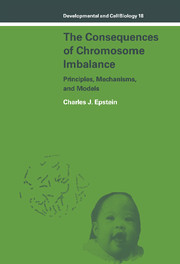Book contents
- Frontmatter
- Contents
- Preface
- Glossary
- PART I INTRODUCTION
- PART II CLINICAL OBSERVATIONS
- 2 The differentiability and variability of phenotypes
- 3 The partitioning of phenotypes
- PART III THE THEORETICAL MECHANISMS AND ISSUES: THE PRIMARY AND SECONDARY EFFECTS OF ANEUPLOIDY
- PART IV EXPERIMENTAL SYSTEMS FOR THE STUDY OF MAMMALIAN AND HUMAN ANEUPLOIDY
- PART V THREE MAJOR CLINICAL PROBLEMS OF HUMAN ANEUPLOIDY
- PART VI CONCLUSION
- Appendix: Standard karyotypes of man and mouse and human cytogenetic nomenclature
- References
- Index
3 - The partitioning of phenotypes
Published online by Cambridge University Press: 14 October 2009
- Frontmatter
- Contents
- Preface
- Glossary
- PART I INTRODUCTION
- PART II CLINICAL OBSERVATIONS
- 2 The differentiability and variability of phenotypes
- 3 The partitioning of phenotypes
- PART III THE THEORETICAL MECHANISMS AND ISSUES: THE PRIMARY AND SECONDARY EFFECTS OF ANEUPLOIDY
- PART IV EXPERIMENTAL SYSTEMS FOR THE STUDY OF MAMMALIAN AND HUMAN ANEUPLOIDY
- PART V THREE MAJOR CLINICAL PROBLEMS OF HUMAN ANEUPLOIDY
- PART VI CONCLUSION
- Appendix: Standard karyotypes of man and mouse and human cytogenetic nomenclature
- References
- Index
Summary
The analysis to this point has permitted us to conclude that characteristic, albeit somewhat variable, syndromes are associated with different chromosome abnormalities. Therefore, clinical data will now be used to determine whether and, if so, to what extent it is possible to recognize the effects of imbalance of specific chromosomal regions in the generation of aneuploid phenotypes. In exploring this issue, I shall make use of two types of information. The first is derived from the examination of double aneuploid states in which one individual is simultaneously aneuploid for two different whole chromosomes or for segments of two different chromosomes. The second is obtained from an analysis of the phenotypic effects of imbalances involving overlapping segments of different lengths from a single chromosome. This analysis will ultimately bring us to a consideration of the issue of phenotypic mapping, i.e., to whether it is possible to assign specific aspects of the phenotype to circumscribed chromosomal regions. In reading the following discussion, the reader must keep in mind the problem of syndrome variability, especially when small numbers of cases are being considered.
Double aneuploidy
Whole chromosomes
Although not qualitatively different from double aneuploidy of chromosome segments, double aneuploidy involving whole chromosomes is easier to examine because the phenotypes of the constituent single aneuploidies are so well characterized.
- Type
- Chapter
- Information
- The Consequences of Chromosome ImbalancePrinciples, Mechanisms, and Models, pp. 22 - 62Publisher: Cambridge University PressPrint publication year: 1986
- 2
- Cited by



